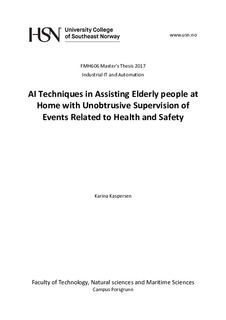| dc.description.abstract | AI techniques are used widely in merging technologies, such as smartphones, PC, Internet of Things (IoT) with cheap and computational power on chips. Device sizes, range of wireless communication and governmental initiatives are part of the focus on implementing assistive technology (AT) in the elderly care sector, enabling elderly to live longer independently at home, while still feel safe.
As fast response and comfort are key issues in AT monitoring systems for elderly, the objective of this present work is to identify sensors and placement on the body and in the ambient environment for timely and correct detection of critical events for unobtrusive monitoring. An experimental procedure was performed involving recordings from various numbers of sensors with different placement to distinguish proper placement and types of sensors to be applied in such systems through training and evaluation of AI models to detect critical events.
A background study on techniques and sensors used in the field, a survey on this type of technology in other parts of the world, as well as in Norway together with ethical aspects of using such technology for elderly, formed the basis of the experimental procedures arranged. Different experiments involving recording of both ciritical as well as trivial events were performed to test and evaluate the generated AI models.
The AI models gave high accuracy (>92 %) of properly identifying fall from non-fall events. An AI model using only wrist-based sensors gave 100 % accuracy after feature reduction, which is promising in such a system for the user to only wear the sensor unit on the wrist, preferably in form of a smartwatch. An geofence thresholdbased AI model for detecting if a user had not come home after a pre-set time was also simulated, which gave a satisfactory result. A proposed system architecture for implementing these detection models in an application software for smartwatch and smartphone are also elaborated. For further work, a suggestion of collecting more experimental data from several subjects has been made to study the model performance from a larger data set, as well as analysing power consumption of such a system running on wireless communication. | nb_NO |
